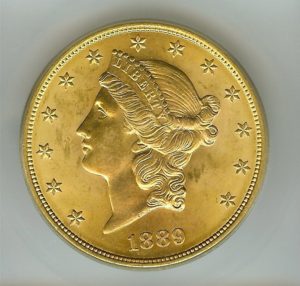$20 Liberty Head Gold Double Eagle (1850-1907)
Got a $20 Liberty Head Double Eagle stashed somewhere in your collection? You should know that you have a treasure in your hand—a huge one.
History of the $20 Liberty Head Gold Double Eagle
Also known as the Coronet double eagle, the American twenty-dollar gold piece was used in 1849 as a pattern coin and from 1850 to 1907 for commerce. It owes its design from the mind of James B. Longacre, the then Chief Engraver of Mint of the United States.
Along with the gold dollar, the double eagle was a direct result of the Congress considering new denominations of gold coinage after gold was  discovered in California in the 1840s and when large amounts of bouillon were brought east.
discovered in California in the 1840s and when large amounts of bouillon were brought east.
The coin was in circulation until in 1907 when it was replaced by the Saint-Gaudens double eagle. In 1933, President Franklin D. Roosevelt had the coins recalled to be melted. This prompted many to place millions of double eagles in bank vaults or to ship them overseas in international transactions.
In the National Numismatic Collection at the Smithsonian, you will find the only known surviving 1849 double eagle. Other types are now being repatriated to meet collectors’ high demand for gold.
Types of $20 Liberty Head Double Eagles
Type 1 (1850-1866)
Also known as No Motto double eagles, the Type 1 coins were struck every year at the San Francisco Mint from 1854 through 1866, at the Philadelphia Mint from 1850 through 1865, and at New Orleans from through 1861.
It featured a woman’s handsome head wearing a diadem with pearl borders and the word LIBERTY inscribed on it. The reverse side featured a spread eagle with a shield on its breast, 13 stars arranged in an oval shape, and the words TWENTY D. and the UNITED STATES OF AMERICA inscribed on it.
Type 2 (1866-1876)
The double eagle’s second design was introduced in 1866. Following the inclusion of the provision in the Mint Act of 1865 that the motto IN GOD WE TRUST should be placed on U.S. coins, the phrase was inscribed within the oval-arranged stars on the coin’s reverse side.
Type 3 (1877-1907)
It was in 1877 when the design for the double eagle was born with the then Chief Engraver William Barber replacing the TWENTY D. on the reverse side with TWENTY DOLLARS and, on the other side, tilted forward Liberty’s head.
Which $20 Liberty Head Gold Coin Is Most Sought After
Nearly every version and type are sought after but not as much as those that are hard to find and those that only a few exist on the market. Even in the poorest condition, the 1891CC, for example, is highly collectible.
Based on past sales, certain types are likely to sell for more than $400,000. These include the 1854 Liberty Head $20 Gold Coin (O) for a predicted value of $485,000 and the 1856 Liberty Head $20 Gold Coin (O) for $475,000.
